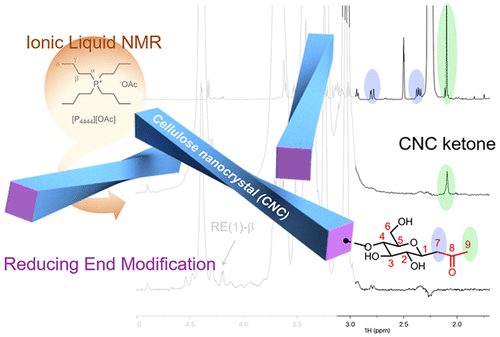当前位置:
X-MOL 学术
›
ACS Macro Lett.
›
论文详情
Our official English website, www.x-mol.net, welcomes your
feedback! (Note: you will need to create a separate account there.)
Knoevenagel Condensation for Modifying the Reducing End Groups of Cellulose Nanocrystals
ACS Macro Letters ( IF 5.1 ) Pub Date : 2019-12-02 , DOI: 10.1021/acsmacrolett.9b00838 Katja Heise 1 , Tetyana Koso 2 , Leena Pitkänen 1 , Antje Potthast 3 , Alistair W T King 2 , Mauri A Kostiainen 1 , Eero Kontturi 1
ACS Macro Letters ( IF 5.1 ) Pub Date : 2019-12-02 , DOI: 10.1021/acsmacrolett.9b00838 Katja Heise 1 , Tetyana Koso 2 , Leena Pitkänen 1 , Antje Potthast 3 , Alistair W T King 2 , Mauri A Kostiainen 1 , Eero Kontturi 1
Affiliation

|
Herein, we demonstrate an effective approach toward functionalization of cellulose nanocrystal (CNC) reducing ends by means of a Knoevenagel condensation reaction with a reactive β-diketone (acetylacetone). The end-wise modification was elucidated by advanced NMR analysis, which was facilitated by dissolving the CNCs in ionic liquid electrolyte and by the concomitant assignment of a model compound derived from d-cellobiose. The diffusion-edited 1H experiment afforded a simple method to identify the assigned model resonances in the reducing end-modified CNCs. The condensations can be carried out in aqueous bicarbonate solutions, avoiding the use of hazardous solvents. Under these preliminary aqueous conditions, end-group conversion of up to 12.5% could be confirmed. These results demonstrate the potential of β-diketone chemistry and the Knoevenagel condensation for functionalizing cellulose reducing ends. Application of this liquid-state NMR method for confirming and quantifying reducing end conversion is also shown to be invaluable. Extension of this chemistry to other 1,3-dicarbonyl compounds and solvation conditions should allow for the topochemical and (axially) chirotopic installation of functional moieties to CNCs, paving the way to asymmetric cellulose-based nanomaterials with unique properties.
中文翻译:

用于修饰纤维素纳米晶体还原端基的 Knoevenagel 缩合
在此,我们展示了一种通过与反应性 β-二酮(乙酰丙酮)进行 Knoevenagel 缩合反应来实现纤维素纳米晶体(CNC)还原末端功能化的有效方法。通过先进的 NMR 分析阐明了末端修饰,通过将 CNCs 溶解在离子液体电解质中以及同时分配衍生自d-纤维二糖的模型化合物来促进这一过程。扩散编辑1H 实验提供了一种简单的方法来识别减少端改性 CNC 中指定的模型共振。缩合可以在碳酸氢盐水溶液中进行,避免使用有害溶剂。在这些初步的含水条件下,可以确认高达 12.5% 的端基转化率。这些结果证明了 β-二酮化学和 Knoevenagel 缩合在纤维素还原末端功能化方面的潜力。应用这种液态 NMR 方法来确认和量化还原端转化率也被证明是无价的。将此化学扩展到其他 1,3-二羰基化合物和溶剂化条件应允许功能部分的拓扑化学和(轴向)手性安装到 CNC,
更新日期:2019-12-02
中文翻译:

用于修饰纤维素纳米晶体还原端基的 Knoevenagel 缩合
在此,我们展示了一种通过与反应性 β-二酮(乙酰丙酮)进行 Knoevenagel 缩合反应来实现纤维素纳米晶体(CNC)还原末端功能化的有效方法。通过先进的 NMR 分析阐明了末端修饰,通过将 CNCs 溶解在离子液体电解质中以及同时分配衍生自d-纤维二糖的模型化合物来促进这一过程。扩散编辑1H 实验提供了一种简单的方法来识别减少端改性 CNC 中指定的模型共振。缩合可以在碳酸氢盐水溶液中进行,避免使用有害溶剂。在这些初步的含水条件下,可以确认高达 12.5% 的端基转化率。这些结果证明了 β-二酮化学和 Knoevenagel 缩合在纤维素还原末端功能化方面的潜力。应用这种液态 NMR 方法来确认和量化还原端转化率也被证明是无价的。将此化学扩展到其他 1,3-二羰基化合物和溶剂化条件应允许功能部分的拓扑化学和(轴向)手性安装到 CNC,











































 京公网安备 11010802027423号
京公网安备 11010802027423号